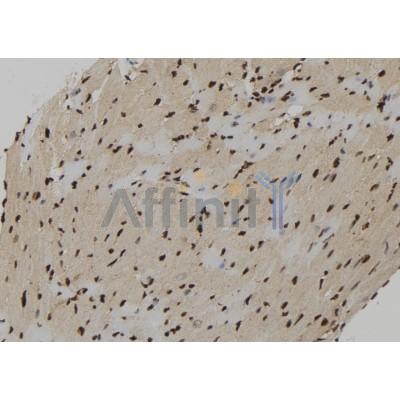CXXC5 Antibody - #DF12378
| Product: | CXXC5 Antibody |
| Catalog: | DF12378 |
| Description: | Rabbit polyclonal antibody to CXXC5 |
| Application: | WB IHC IF/ICC |
| Reactivity: | Human, Mouse, Rat, Monkey |
| Prediction: | Pig, Bovine, Horse, Dog, Chicken |
| Mol.Wt.: | 35-40 kDa; 33kD(Calculated). |
| Uniprot: | Q7LFL8 |
| RRID: | AB_2845183 |
Related Downloads
Protocols
Product Info
*The optimal dilutions should be determined by the end user. For optimal experimental results, antibody reuse is not recommended.
*Tips:
WB: For western blot detection of denatured protein samples. IHC: For immunohistochemical detection of paraffin sections (IHC-p) or frozen sections (IHC-f) of tissue samples. IF/ICC: For immunofluorescence detection of cell samples. ELISA(peptide): For ELISA detection of antigenic peptide.
Cite Format: Affinity Biosciences Cat# DF12378, RRID:AB_2845183.
Fold/Unfold
CF5; CXXC finger 5 protein; CXXC finger protein 5; CXXC-type zinc finger protein 5; CXXC5; CXXC5_HUMAN; HSPC195; Putative MAPK-activating protein PM08; Putative NF-kappa-B-activating protein 102; retinoid-inducible nuclear factor; RINF; TCCCIA00297; WID; WT1-induced Inhibitor of Dishevelled;
Immunogens
A synthesized peptide derived from human CXXC5, corresponding to a region within the internal amino acids.
- Q7LFL8 CXXC5_HUMAN:
- Protein BLAST With
- NCBI/
- ExPASy/
- Uniprot
MSSLGGGSQDAGGSSSSSTNGSGGSGSSGPKAGAADKSAVVAAAAPASVADDTPPPERRNKSGIISEPLNKSLRRSRPLSHYSSFGSSGGSGGGSMMGGESADKATAAAAAASLLANGHDLAAAMAVDKSNPTSKHKSGAVASLLSKAERATELAAEGQLTLQQFAQSTEMLKRVVQEHLPLMSEAGAGLPDMEAVAGAEALNGQSDFPYLGAFPINPGLFIMTPAGVFLAESALHMAGLAEYPMQGELASAISSGKKKRKRCGMCAPCRRRINCEQCSSCRNRKTGHQICKFRKCEELKKKPSAALEKVMLPTGAAFRWFQ
Predictions
Score>80(red) has high confidence and is suggested to be used for WB detection. *The prediction model is mainly based on the alignment of immunogen sequences, the results are for reference only, not as the basis of quality assurance.
High(score>80) Medium(80>score>50) Low(score<50) No confidence
Research Backgrounds
May indirectly participate in activation of the NF-kappa-B and MAPK pathways. Acts as a mediator of BMP4-mediated modulation of canonical Wnt signaling activity in neural stem cells (By similarity). Required for DNA damage-induced ATM phosphorylation, p53 activation and cell cycle arrest. Involved in myelopoiesis. Transcription factor. Binds to the oxygen responsive element of COX4I2 and represses its transcription under hypoxia conditions (4% oxygen), as well as normoxia conditions (20% oxygen). May repress COX4I2 transactivation induced by CHCHD2 and RBPJ. Binds preferentially to DNA containing cytidine-phosphate-guanosine (CpG) dinucleotides over CpH (H=A, T, and C), hemimethylated-CpG and hemimethylated-hydroxymethyl-CpG.
Nucleus. Cytoplasm.
Note: Colocalizes with DVL1 in large bodies localized just outside the nuclear membrane.
The CXXC zinc finger mediates binding to CpG-DNA.
Restrictive clause
Affinity Biosciences tests all products strictly. Citations are provided as a resource for additional applications that have not been validated by Affinity Biosciences. Please choose the appropriate format for each application and consult Materials and Methods sections for additional details about the use of any product in these publications.
For Research Use Only.
Not for use in diagnostic or therapeutic procedures. Not for resale. Not for distribution without written consent. Affinity Biosciences will not be held responsible for patent infringement or other violations that may occur with the use of our products. Affinity Biosciences, Affinity Biosciences Logo and all other trademarks are the property of Affinity Biosciences LTD.



